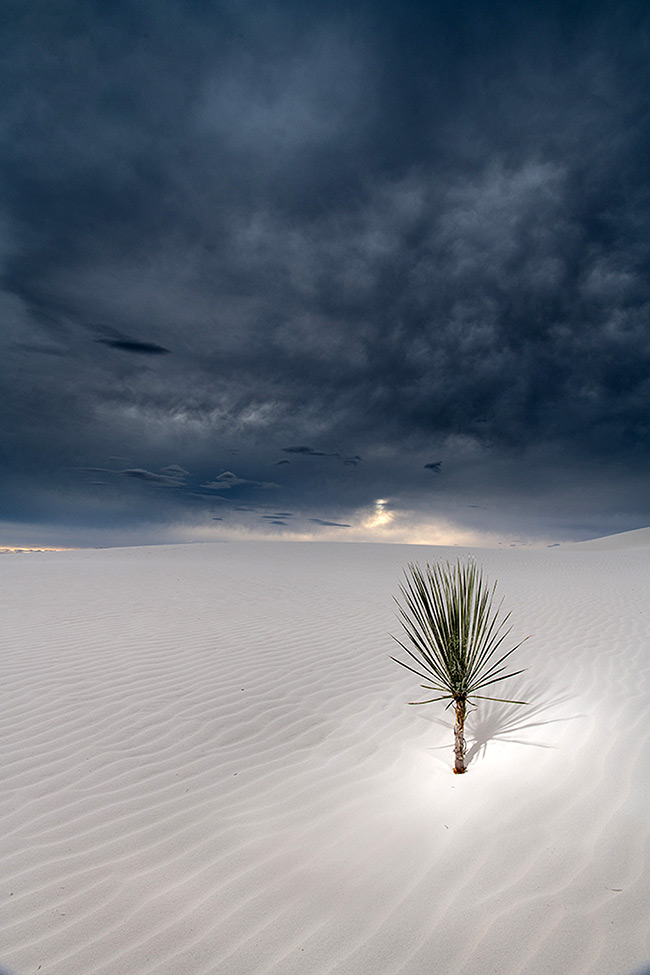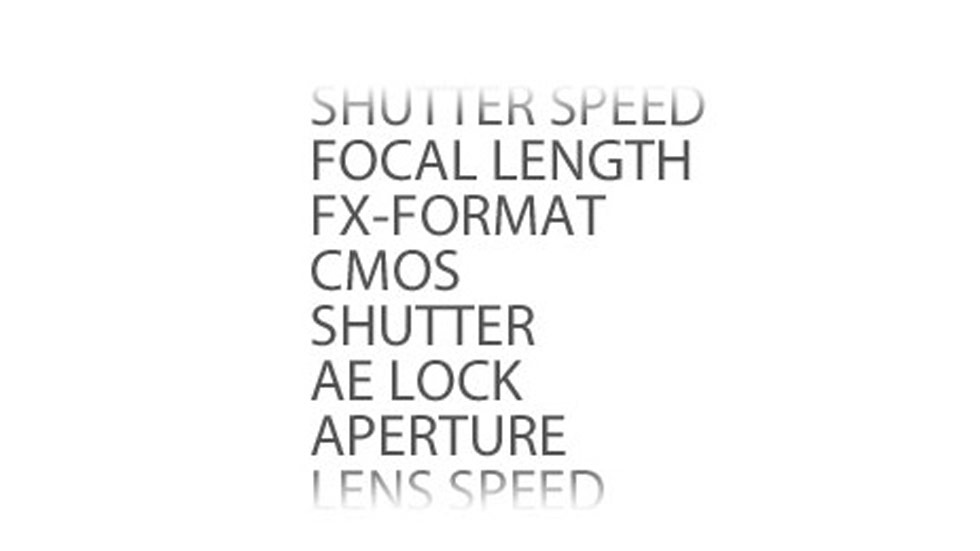Create With Light: Flash in the Great Outdoors
The scene as Tom saw it on a cold autumn morning in Ouray, Colorado. "It works—Aspen leaves on a piece of wood, in the shade, with the gray, cool look a perfect mood for the photo. I really didn't need to do anything." D810, AF-S NIKKOR 70-200mm f/4G ED VR, 1/100 second, f/5.6, ISO 200, aperture priority, Matrix metering.
But "need" wasn't the issue. Wanting to see what flash might do for the image, he moved the leaves on the wood to affect how the SB-910's light would hit them and set the flash down at the nine-o'clock position. "The light created a warm color and a little shadow. It looked good, but I thought, What am I trying to photograph here? What is this photo about? And here I think no flash is a better choice because I didn't really want to warm this up." (Our take: the first photo is what we see in nature; we like it for its discovery; the flash shot is a framed photo hung on the wall above a rustic table for sale in an upscale furniture shop.) D810, AF-S NIKKOR 70-200mm f/4G ED VR, 1/200 second, f/7.1, ISO 200, manual exposure, Matrix metering.
Here's a suggestion for better, more creative, more imaginative landscape photos: when you're packing your camera bag, add to the camera, lenses and filters one more item that spells creative control: a Nikon SB Speedlight.
And if you want to get really creative about it, add an SU-800 Wireless Speedlight Commander unit for off-camera shooting with flash.
We know what you're probably thinking: Hey, we're going to be outdoors; there's plenty of light. Yes, there is. But the light we're suggesting you add is a different kind of light. It's light you control; light that responds to your imagination and experimentation.
And because you're using Nikon Speedlights, it's light that's easy to control. No formulas, no guide numbers, no pacing off or measuring distances. Set the flash for Auto TTL and you're good to go. Need to control the Speedlight's output? Do it right from the camera when the flash is mounted on the hot-shoe, or from the SU-800 Commander when you want to shoot wireless, off-camera flash.
The learning curve? About ten minutes to master the basics.
But before we talk about the how, let's get to the why.
Tom's wife, Cree, took this setup shot of Tom taking the pinecone flash photo with a Rogue FlashBender on his SB-5000 acting as a snoot to direct the light. "It's basically a piece of fabric you can roll into a tube to create a snoot—it's super handy."
"The idea was, Can you create sunlight with a Speedlight?" Tom says, and his SB-5000 was fitted with two CTO gels to really warm up the light. "On an overcast day, there was not much going on but pinecone textures, but with flash, things start to happen as the extreme angle of the flash creates a shaft of sunlight. I underexposed this shot by three stops to darken the daylight exposure so only the flash would illuminate the scene." D850, AF-S NIKKOR 70-200mm f/4G ED VR, 1/200 second, f/9, ISO 200, manual exposure, Matrix metering.
Outside Shots
When outdoor and adventure photographer Tom Bol talks to his workshop students about outdoor flash and demonstrates some of its possibilities, his first aim is to show how a flash can help them deal with challenging landscape situations. "It will create light where there isn't any, or there isn't enough," he says, "and it will allow you to control the direction of that light if you position the flash off camera."
Sand dunes in Winnemucca, Nevada, on an overcast day. With no direct sunlight there's no definition to the texture, no shadows to accentuate depth in the waves of sand. There were only two things to do: take this picture for the "before," and bring out the Speedlight to create the "after." D850, AF-S NIKKOR 24mm f/1.4G ED, 1/320 second, f/11, ISO 100, aperture priority, Matrix metering.
Tom placed his SB-910, fitted with a CTO gel, on the sand in the nine-o'clock position and fired it across the scene to create greater contrast and shadows in the foreground ripples. He knew the back ripples wouldn't get the flash's effect, so he underexposed the image so the ambient light "darkened" the tone of everything, even the background sand and the sky. D850, AF-S NIKKOR 24mm f/1.4G ED, 1/250 second, f/13, ISO 32, manual exposure, Matrix metering.
Flash can also reduce contrast in an image—or add it, if that's what you're looking for. And it can set off your subject to call attention to it. Not to mention reveal detail and give an image more dimension, drama and color.
"We're so conditioned to use light to take out the shadow under a hat brim in an outdoor or travel portrait," Tom points out, "but how about instances where we want to create shadows? Or use flash so we can deliberately underexpose the background and make it basically pitch black?"
When Tom took this photo at White Sands National Monument in New Mexico, he had another idea in mind. "Nothing wrong with the scene, but I thought I'd like to darken the clouds and create a storm look to add some drama." D850, AF-S NIKKOR 20mm f/1.8G ED, 1/25 second, f/16, ISO 160, manual exposure, Matrix metering.
With his SB-910 off camera, Tom used a wraparound snoot to focus the light to a narrower beam and create the Yucca plant shadow as he held the flash in his left hand at ten o'clock. He'd changed the ambient exposure to underexpose one-and-a-half stops to darken the sky. "It's a different, deliberate look," he says, "with no effort to hide that this is a flash photo." Later, a white balance adjustment in post brightened the sand. D850, AF-S NIKKOR 20mm f/1.8G ED, 1/40 second, f/16, ISO 100, manual exposure, Matrix metering.
Most of the time you'll likely want flash to be invisible. Tom's photos of the birds with the little catch lights in their eyes don't announce the presence of flash. Same for the subtle, soft light that gives an added dimension to the slot canyon. In those cases, flash doesn't announce its contribution.
On the other hand, there are times when you might want flash to show itself in order to create a different kind of picture, one that's beyond the faithful recording of a scene.
And there's a third hand: some folks will look at some of Tom's comparisons and decide they prefer the no-flash photo and the mood it sets. It's your call—give it a (flash) shot and decide what works for you.
The sunlight from above set the slot canyon scene in Bryce Canyon National Park, but to Tom's way of thinking there wasn't enough detail in the image. So he decided to use flash to open up the right side of the image to give viewers more of a sense of the slot canyon's walls. D500, AF-S NIKKOR 20mm f/1.8G ED, 1/125 second, f/5.6, ISO 100, manual exposure, Matrix metering.
Tom's SB-910 Speedlight, set on a rock at the eight-o'clock position and aimed up, reveals the rocks on the right side, increasing the sense of enclosure. "This is more of what it felt like being there," he says. There was a full CTO (Color Temperature Orange) gel on the flash "to warm things up a bit." D500, AF-S NIKKOR 20mm f/1.8G ED, 1/125 second, f/5.6, ISO 100, manual exposure, Matrix metering.
Flash is a tool to open up creative possibilities for landscape photography.
The Milky Way over Ouray, Colorado, captured in a 20-second exposure. D500, AF-S NIKKOR 14-24mm f/2.8G ED, 20 seconds, f/2.8, ISO 2500, manual exposure, Matrix metering.
Easy Does It
As far as the ten-minute learning curve, Tom admits that sometimes in the workshops he winds up battling the idea that flash is complex and hard to do. "I tell people that it's as simple as putting the flash on your camera, turning the camera on and taking a picture. The technology is going to work: in the classic TTL mode, the Nikon Speedlight is going to add the right amount of light to the scene. I'm in TTL mode most of the time when I'm using my Speedlights, and if I don't like the look of the photo, I'll go plus or minus power at the Commander or the on-camera flash."
The color on the vermilion flycatcher was pretty good, but the dull background and the overcast day weren't helping at all. D850, AF-S NIKKOR 600mm f/4E FL ED VR, 1/1600 second, f/5.6, ISO 640, aperture priority, Matrix metering.
The on-camera SB-5000 added a catch light and brightened the bird a bit. For this and the previous comparison set, Tom had a 1.4 AF-S Teleconverter TC-14E II on his 600mm lens. D850, AF-S NIKKOR 600mm f/4E FL ED VR, 1/1600 second, f/5.6, ISO 640, aperture priority, Matrix metering.
And the rest of the ten minutes? "That's the second step—where you use the flash off camera to control the direction of the light and get the right angle for the articulated shadows that allow you to 'recreate' sunlight and making it look like the sun is beaming through a scene. When you place the flash off camera, you're pretty much trying to recreate natural light."
You'll find a lot of subjects at the Butterfly Pavilion in Westminster, Colorado. The only problem is...they're butterflies. "These guys never stay anywhere longer than ten seconds, maybe 15 if you're lucky." Here the butterfly stuck around long enough, but the background was a major distraction. D800, AF Micro-Nikkor 105mm f/2.8D, 1/60 second, f/16, ISO 2500, aperture priority, Matrix metering.
And here flash shows how it can help clean up, or take out, a background that's not helping the shot. Tom took this with his SB-910 on camera and underexposed the background about two stops to eliminate it. D800, AF Micro-Nikkor 105mm f/2.8D, 1/250 second, f/13, ISO 400, manual exposure, Matrix metering.
Off-camera use of Nikon Speedlights is just about as easy as flash-on-camera. Mount your SU-800 Commander on the camera, place your Speedlight anywhere you want it in line-of-sight to the Commander and control the light output of the flash right from the camera position. (If you want to move up a notch to radio control of your Speedlight—meaning that line-of-sight access isn't necessary—Nikon's SB-5000 and WR-R10 wireless radio transmitter will handle that for you.)
No flash here, just a patient yellow-crowned night heron waiting for a fish in a swampy area of Edinburg, Texas. D850, AF-S NIKKOR 600mm f/4E FL ED VR, 1/640 second, f/5.6, ISO 800, aperture priority, Matrix metering.
Tom keeps it all simple: he typically carries the SU-800 and one Speedlight, though he's lately started using the SB-5000 and the WR-R10. And while Nikon flash gear is both technically amazing and incredibly easy to use, what's really the key to effective flash photos is to keep ideas and possibilities in mind. "You're in a great location, but it's a gray day," Tom says. "The light's flat—it's giving you nothing. That's the time to get out the Speedlight and pop a little flash onto that tree trunk or across those leaves and give yourself the chance to create something that looks good. I always tell my workshop classes that flash is a tool to open up creative possibilities for landscape photography. "
Tom shot two exposures, each with flash, to pop some light on the redwoods, and let the D850 do the blend. "I shot the left-hand tree pretty much straight on, then the biggest tree from the right side at three o'clock. That's ambient light hitting the middle tree—no flash there." Cree held the SB-5000 as Tom took the pictures. D850, AF-S NIKKOR 20mm f/1.8G ED, 1/10 second, f/5.6, ISO 200, manual exposure, Matrix metering.


























